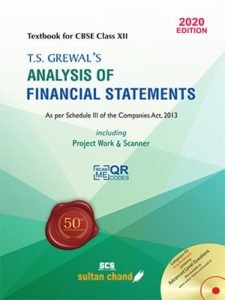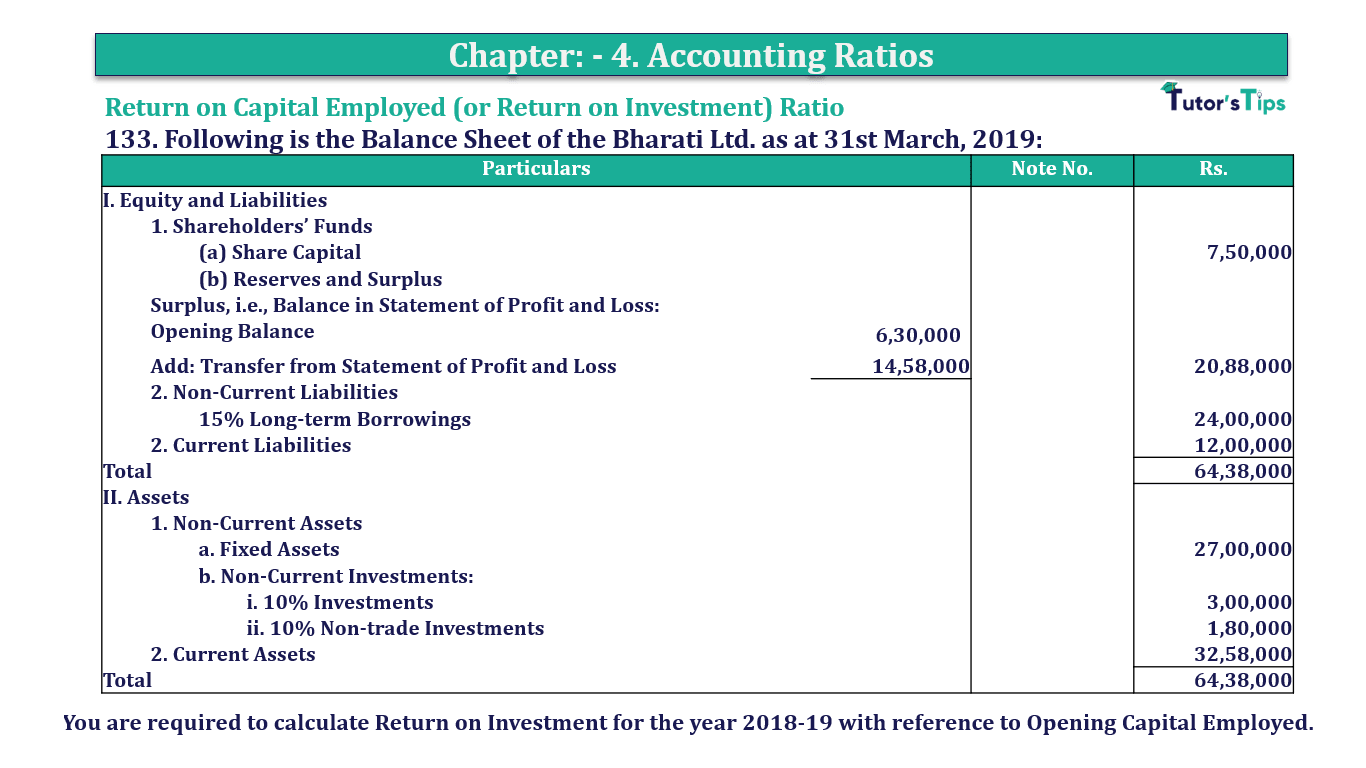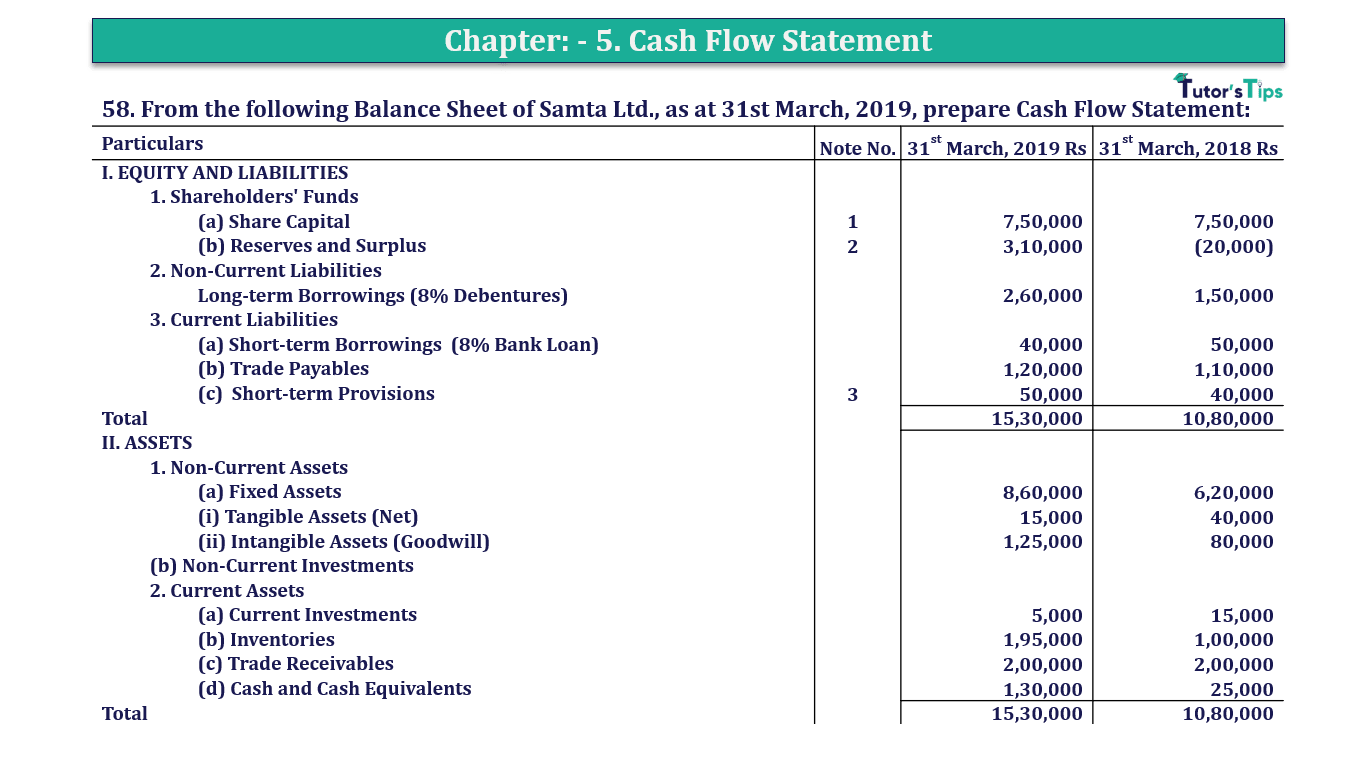Question 133 Chapter 4 of +2-B
Table of Contents
Return on Capital Employed (or Return on Investment) Ratio
133. Following is the Balance Sheet of the Bharati Ltd. as at 31st March, 2019:
| Particulars | Note No. | Rs. | |
| I. Equity and Liabilities | |||
| 1. Shareholders’ Funds | |||
| (a) Share Capital | 7,50,000 | ||
| (b) Reserves and Surplus | |||
| Surplus, i.e., Balance in Statement of Profit and Loss: | |||
| Opening Balance | 6,30,000 | ||
| Add: Transfer from Statement of Profit and Loss | 14,58,000 | 20,88,000 | |
| 2. Non-Current Liabilities | |||
| 15% Long-term Borrowings | 24,00,000 | ||
| 2. Current Liabilities | 12,00,000 | ||
| Total | 64,38,000 | ||
| II. Assets | |||
| 1. Non-Current Assets | |||
| a. Fixed Assets | 27,00,000 | ||
| b. Non-Current Investments: | |||
| i. 10% Investments | 3,00,000 | ||
| ii. 10% Non-trade Investments | 1,80,000 | ||
| 2. Current Assets | 32,58,000 | ||
| Total | 64,38,000 |
You are required to calculate Return on Investment for the year 2018-19 with reference to Opening Capital Employed.
The solution of Question 133 Chapter 4 of +2-B: –
| Interest on borrowings | = | Rs. 24,00,000 x 15% |
| = | Rs. 3,60,000 | |
| Net Profit before Tax | = | Net Profit after tax + Interest on borrowings – Interest received on Non-trade Investments |
| = | Rs. 14,58,000 + Rs. 3,60,000 – Rs. 18, 000 | |
| = | Rs. 18,00,000 |
|
| Capital Employed | = | Shareholder’s Funds Opening + Non-Current Liabilities Opening– Non-Trade Investment |
| = | Rs. 7,50,000 + Rs. 6,30,000 + Rs. 24,00,000 – Rs 1,80,000 | |
| = | Rs. 36,00,000 |
| Net Profit Ratio | = | Profit before Interest and Tax | X | 100 |
| Capital Employed |
| Net Profit Ratio | = | Rs. 18,00,000 | X | 100 |
| Rs. 36,00,000 | ||||
| = | 50% |
Advertisement-X
Balance Sheet: Meaning, Format & Examples
Thanks, Please Like and share with your friends
Comment if you have any question.
Also, Check out the solved question of previous Chapters: –
T.S. Grewal’s Double Entry Book Keeping +2 (Vol. I: Accounting for Not-for-Profit Organizations and Partnership Firms)
- Chapter No. 1 – Financial Statement of Not-For-Profit Organisations
- Chapter No. 2 – Accounting for Partnership Firms – Fundamentals
- Chapter No. 3 – Goodwill: Nature and Valuation
- Chapter No. 4 – Change in Profit-Sharing Ratio Among the Existing Partners
- Chapter No. 5 – Admission of a Partner
- Chapter No. 6 – Retirement/Death of a Partner
- Chapter No. 7 – Dissolution of a Partnership Firm
T.S. Grewal’s Double Entry Book Keeping (Vol. II: Accounting for Companies)
- Chapter No. 8 – Company Accounts – Accounting for Share Capital
- Chapter No. 9 – Company Accounts – Issue of Debentures
- Chapter No. 10 – Redemption of Debentures
T.S. Grewal’s Double Entry Book Keeping (Vol. II: Accounting for Companies)
- Chapter No. 1 – Financial Statements of a Company
- Chapter No. 2 – Financial Statement Analysis
- Chapter No. 3 – Tools of Financial Statement Analysis – Comparative Statements and Common- Size Statements
- Chapter No. 4 – Accounting Ratios
- Chapter No. 5 – Cash Flow Statement
Check out T.S. Grewal +2 Book 2020@ Official Website of Sultan Chand Publication








Leave a Reply